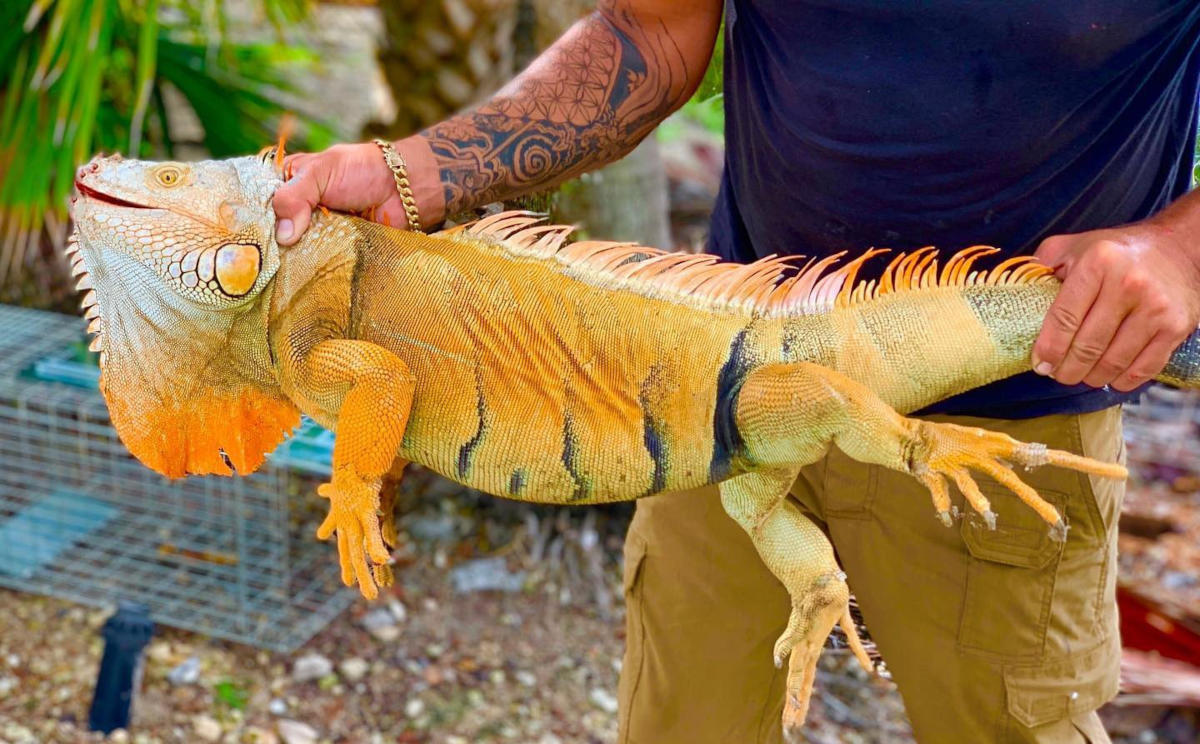Effective Iguana Control Strategies

|
Michael Ronquillo
Humane Iguana Control
Published: 2-Oct-2023
Updated on: 10-Oct-2023
|
Introduction
The presence of iguanas in South Florida has become a growing concern due to their impact on ecosystems, agricultural activities, and being a major nuisance to urban residents and businesses. To mitigate the negative effects of iguana populations, it is important to implement effective iguana removal tactics and long-term management strategies. This article outlines some recommended approaches for controlling and reducing iguana numbers.
Problems Caused by Iguanas
- Nuisance: Many people do not like seeing high numbers of iguanas around especially when they damage ornamental plants, fruits, and vegetables, or when they defecate on surfaces. They can run fast and are both excellent climbers and swimmers. They can readily climb trees, poles, and other vertical structures. They can escape any threat by diving into the water and staying there until they feel safe again!
- Ecological impact: Iguanas are not native to South Florida and their presence has disrupted the natural balance of the ecosystem. They feed on foliage, flowers, and fruits, damaging local vegetation and often decimating agricultural crops. These voracious eaters also impact nesting sites for native birds and other reptiles. Understanding their negative ecological impact is crucial in developing effective strategies for deterrence.
- Structural and property damage: Beyond their negative environmental impacts, iguanas can cause extensive damage to residential and commercial properties. Their burrowing activities undermine infrastructure, foundations, levees, and seawalls. Furthermore, their sharp claws and teeth can gnaw on electrical wiring, pipes, and landscaping. Uncontrolled iguana populations can quickly lead to costly repairs, making proactive deterrence a wise investment. Iguanas can also contribute to erosion along the banks of lakes and streams by feeding on vegetation and their burrowing activities.
- Diseases: Iguanas can pose health risks to humans. They readily defecate on lawns, sidewalks, and any other surface they walk on. They can carry and transmit bacteria such as E. coli and Salmonella through their feces, which can contaminate surfaces, food, and water sources. Direct contact with iguana feces or contaminated surfaces can lead to Salmonella infection, resulting in gastrointestinal illness in humans. It is essential to practice good hygiene, such as pressure washing contaminated surfaces, disinfecting with bleach or other disinfecting agents, and washing hands thoroughly after contact with iguanas or contaminated surfaces.
- Bites and scratches: When touched, iguanas can potentially bite people and scratch the skin with their claws and or tails. This is especially true with the adults that are larger and more powerful.
Identifying Species:
There are three common species of iguanas in South Florida: the green iguana (Iguana iguana), black spiny-tailed iguana (Ctenosaura similis), and the Mexican spiny-tailed iguana (Ctenosaura pectinate). The most common species is the green iguana which occurs in the lower half of Florida, mostly along the coastal areas, but also in some inland areas. Each species has specific characteristics and habits that should be taken into consideration when planning iguana removal and control measures. Understanding their feeding habits, reproduction patterns, and habitat requirements is vital for developing effective management strategies.
Management
Iguanas can be managed through various methods. Here is a summary of the most common methods used for iguana control:
- Habitat modification: Iguanas are highly adapted to living in tropical and subtropical environments. One way to reduce their presence is to modify their habitat to make it less hospitable for them. Implementing measures such as heavy trimming or removing vegetations that serve as a bridge to buildings or those that serve as a food source gg or burrowing site cover can help with reducing their numbers. Planting vegetation with strong and repellent smell such as rosemary and citrus, or plants with toxic sap such as such as milkweed and oleander can highly discourage iguanas from entering or at least damaging the landscape. Collaborating with local landowners or residents to address habitat modification collectively can have a broader impact.
- Exclusion methods: Installing barriers such as electric fencing or wrapping trees with sheet metal (a common method for rodent control) can prevent iguanas from entering properties.
- Trapping and removal: Iguanas can be captured using cage or net traps or manually using a noose pole. Live traps, baited with suitable food such as fruits, can be used to capture iguanas for later disposal. However, please note that in many jurisdictions, it is illegal to release or relocate captured iguanas. It is essential to respect local laws and regulations regarding the handling and disposal of invasive species. It is recommended to contact local professional pest control experts specializing in iguana removal to ensure legal and safe disposal methods are followed. These professionals have the knowledge, experience, and resources to effectively capture and humanely dispose of captured iguanas while adhering to local regulations.
- Shooting and removal: Shooting iguanas with air guns is a fast and effective method of managing them. Shooting helps the operator to target iguanas high on trees, on the opposite side of lakes, or in hard-to-reach areas such as in swampy areas or areas with very dense vegetation. Dead bodies of iguanas must be collected and removed whenever possible to reduce contamination. However, sometimes iguanas may fall into lakes, or die in hard-to-access areas, making it difficult to locate and collect the bodies.
- Monitoring: Continuous monitoring and research efforts are necessary to evaluate the effectiveness of implemented control measures and adapt strategies accordingly. Monitoring the size and distribution of iguana populations, as well as their behavior and impact on the environment, provides valuable data for making informed decisions and improving management practices.
Raising awareness about the ecological and economic impacts of iguanas is crucial for garnering support and cooperation from the general public. Engaging in educational programs, workshops, or public campaigns can help instill a sense of responsibility and encourage individuals to report iguana sightings or seek professional assistance when needed. Sharing information about the negative consequences of illegal iguana release or relocation is vital to discourage such actions.
Conclusion
Managing iguana populations requires a multifaceted approach that combines habitat modification, exclusion, trapping and shooting, professional removal, and ongoing monitoring. By implementing these strategies in a coordinated manner, we can reduce the negative impacts of iguanas on our ecosystems and urban areas.
